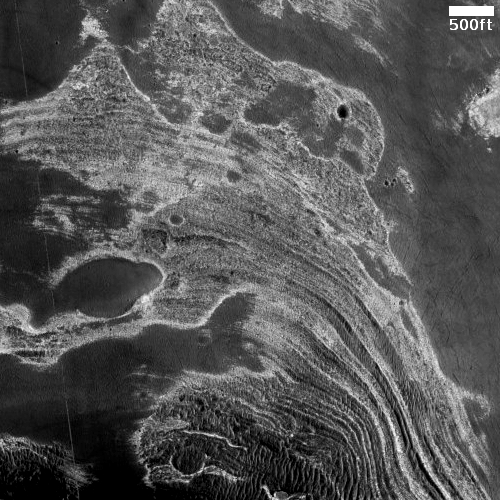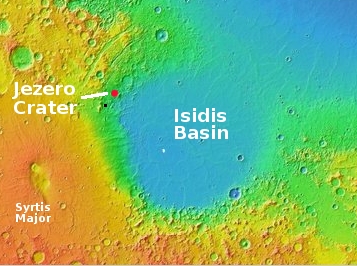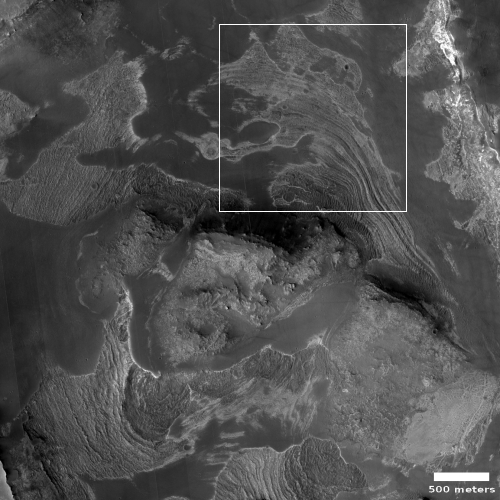Strange terrain southwest of Jezero Crater
Cool image time! The photo to the right, cropped and reduced to post here, was taken on June 16, 2022 by the high resolution camera on Mars Reconnaissance Orbiter (MRO). It shows what the scientists have merely label “landforms.”
I instead call them strange. Clearly we are seeing exposed layering that surrounds the mesa in the middle of the image. This in turn suggests that the mesa top was once the surface of this whole region, and that region had been formed by the repeated placement of multiple sedimentary layers. Then, over time the surrounding terrain was eroded away, exposing those underlying layers.
Even so, some of the parallel lines do not appear to be layers, but striations etched into the ground. To get a better look, the white box marks the area covered by a full resolution close-up below.


I have enhanced the contrast to bring out the details. The downward grade should be to the northeast, but as you can see, in many places there does not appear to be any downward grade at all. Instead, we appear to be looking at a series of parallel lines, alternating light and dark.
If there is little or no grade, this could mean that at those locations the layers are actually almost vertical, so that we are looking down at their exposed ends. Under this hypothesis, the layers have mostly eroded equally, but the slight differences in their density has caused some to be slightly more resistant than others. This theory is strengthened by the shadows. Because the sunlight is coming from the west, the contrast between the lines oriented north-south in the lower right is greater. The lighter lines, likely ridges, stick up slightly, casting shadows on the adjacent lower rifts to the east. The contrast is less pronounced in the lines in the middle of the image, oriented mostly east-west, because the sunlight is reaching the bottoms of both the high and low lines.
The black dot on the overview map to the right tells us where this image is located on Mars, about fifty miles to the southwest of Jezero Crater where Perseverance is roving, and about 250 miles northeast of the caldera of the shield volcano Syrtis Major.
Orbital images and data has revealed that the region to the west of Jezero is extremely varied, with many minerals and strange formations not unlike today’s cool image. Though it is unlikely that Perseverance will ever reach this spot, there are numerous similar features much closer to the Jezero in this western region that the rover will surely reach in the coming years.
On Christmas Eve 1968 three Americans became the first humans to visit another world. What they did to celebrate was unexpected and profound, and will be remembered throughout all human history. Genesis: the Story of Apollo 8, Robert Zimmerman's classic history of humanity's first journey to another world, tells that story, and it is now available as both an ebook and an audiobook, both with a foreword by Valerie Anders and a new introduction by Robert Zimmerman.
The print edition can be purchased at Amazon or from any other book seller. If you want an autographed copy the price is $60 for the hardback and $45 for the paperback, plus $8 shipping for each. Go here for purchasing details. The ebook is available everywhere for $5.99 (before discount) at amazon, or direct from my ebook publisher, ebookit. If you buy it from ebookit you don't support the big tech companies and the author gets a bigger cut much sooner.
The audiobook is also available at all these vendors, and is also free with a 30-day trial membership to Audible.
"Not simply about one mission, [Genesis] is also the history of America's quest for the moon... Zimmerman has done a masterful job of tying disparate events together into a solid account of one of America's greatest human triumphs."--San Antonio Express-News
Cool image time! The photo to the right, cropped and reduced to post here, was taken on June 16, 2022 by the high resolution camera on Mars Reconnaissance Orbiter (MRO). It shows what the scientists have merely label “landforms.”
I instead call them strange. Clearly we are seeing exposed layering that surrounds the mesa in the middle of the image. This in turn suggests that the mesa top was once the surface of this whole region, and that region had been formed by the repeated placement of multiple sedimentary layers. Then, over time the surrounding terrain was eroded away, exposing those underlying layers.
Even so, some of the parallel lines do not appear to be layers, but striations etched into the ground. To get a better look, the white box marks the area covered by a full resolution close-up below.


I have enhanced the contrast to bring out the details. The downward grade should be to the northeast, but as you can see, in many places there does not appear to be any downward grade at all. Instead, we appear to be looking at a series of parallel lines, alternating light and dark.
If there is little or no grade, this could mean that at those locations the layers are actually almost vertical, so that we are looking down at their exposed ends. Under this hypothesis, the layers have mostly eroded equally, but the slight differences in their density has caused some to be slightly more resistant than others. This theory is strengthened by the shadows. Because the sunlight is coming from the west, the contrast between the lines oriented north-south in the lower right is greater. The lighter lines, likely ridges, stick up slightly, casting shadows on the adjacent lower rifts to the east. The contrast is less pronounced in the lines in the middle of the image, oriented mostly east-west, because the sunlight is reaching the bottoms of both the high and low lines.
The black dot on the overview map to the right tells us where this image is located on Mars, about fifty miles to the southwest of Jezero Crater where Perseverance is roving, and about 250 miles northeast of the caldera of the shield volcano Syrtis Major.
Orbital images and data has revealed that the region to the west of Jezero is extremely varied, with many minerals and strange formations not unlike today’s cool image. Though it is unlikely that Perseverance will ever reach this spot, there are numerous similar features much closer to the Jezero in this western region that the rover will surely reach in the coming years.
On Christmas Eve 1968 three Americans became the first humans to visit another world. What they did to celebrate was unexpected and profound, and will be remembered throughout all human history. Genesis: the Story of Apollo 8, Robert Zimmerman's classic history of humanity's first journey to another world, tells that story, and it is now available as both an ebook and an audiobook, both with a foreword by Valerie Anders and a new introduction by Robert Zimmerman.
The print edition can be purchased at Amazon or from any other book seller. If you want an autographed copy the price is $60 for the hardback and $45 for the paperback, plus $8 shipping for each. Go here for purchasing details. The ebook is available everywhere for $5.99 (before discount) at amazon, or direct from my ebook publisher, ebookit. If you buy it from ebookit you don't support the big tech companies and the author gets a bigger cut much sooner.
The audiobook is also available at all these vendors, and is also free with a 30-day trial membership to Audible.
"Not simply about one mission, [Genesis] is also the history of America's quest for the moon... Zimmerman has done a masterful job of tying disparate events together into a solid account of one of America's greatest human triumphs."--San Antonio Express-News



Looks like sedimentary strata, conformable with the ridge to the ‘north’. Would be very helpful to have stereopair photos of these Martian features. As it is, we really don’t have a sense of elevation change. We can hope to have that capability some day . . .